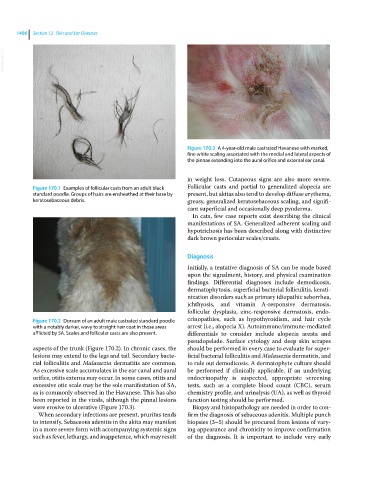Page 1558 - Clinical Small Animal Internal Medicine
P. 1558
1496 Section 12 Skin and Ear Diseases
VetBooks.ir
Figure 170.3 A 4‐year‐old male castrated Havanese with marked,
fine white scaling associated with the medial and lateral aspects of
the pinnae extending into the aural orifice and external ear canal.
in weight loss. Cutaneous signs are also more severe.
Figure 170.1 Examples of follicular casts from an adult black Follicular casts and partial to generalized alopecia are
standard poodle. Groups of hairs are ensheathed at their base by present, but akitas also tend to develop diffuse erythema,
keratosebaceous debris. greasy, generalized keratosebaceous scaling, and signifi-
cant superficial and occasionally deep pyoderma.
In cats, few case reports exist describing the clinical
manifestations of SA. Generalized adherent scaling and
hypotrichosis has been described along with distinctive
dark brown periocular scales/crusts.
Diagnosis
Initially, a tentative diagnosis of SA can be made based
upon the signalment, history, and physical examination
findings. Differential diagnoses include demodicosis,
dermatophytosis, superficial bacterial folliculitis, kerati-
nization disorders such as primary idiopathic seborrhea,
ichthyosis, and vitamin A‐responsive dermatosis,
follicular dysplasia, zinc‐responsive dermatosis, endo-
Figure 170.2 Dorsum of an adult male castrated standard poodle crinopathies, such as hypothyroidism, and hair cycle
with a notably darker, wavy to straight hair coat in those areas arrest (i.e., alopecia X). Autoimmune/immune‐mediated
afflicted by SA. Scales and follicular casts are also present. differentials to consider include alopecia areata and
pseudopelade. Surface cytology and deep skin scrapes
aspects of the trunk (Figure 170.2). In chronic cases, the should be performed in every case to evaluate for super-
lesions may extend to the legs and tail. Secondary bacte- ficial bacterial folliculitis and Malassezia dermatitis, and
rial folliculitis and Malassezia dermatitis are common. to rule out demodicosis. A dermatophyte culture should
As excessive scale accumulates in the ear canal and aural be performed if clinically applicable. If an underlying
orifice, otitis externa may occur. In some cases, otitis and endocrinopathy is suspected, appropriate screening
excessive otic scale may be the sole manifestation of SA, tests, such as a complete blood count (CBC), serum
as is commonly observed in the Havanese. This has also chemistry profile, and urinalysis (UA), as well as thyroid
been reported in the vizsla, although the pinnal lesions function testing should be performed.
were erosive to ulcerative (Figure 170.3). Biopsy and histopathology are needed in order to con-
When secondary infections are present, pruritus tends firm the diagnosis of sebaceous adenitis. Multiple punch
to intensify. Sebaceous adenitis in the akita may manifest biopsies (3–5) should be procured from lesions of vary-
in a more severe form with accompanying systemic signs ing appearance and chronicity to improve confirmation
such as fever, lethargy, and inappetence, which may result of the diagnosis. It is important to include very early

